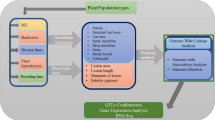Abstract
This study aimed to employ plant print identification to screen a wild-type soybean (Glycine soja Seib. and Zucc.) and then hybridize it with a cultivated soybean (Glycine max (L.) Merr.) (Lu, Chin Sci Bull 43:2074–2078, 1998) with a view to produce a salt-resistant variety. Scanning electron microscopy, optical microscopy, and paraffin sectioning were employed to compare two varieties of wild soybeans (#028 and #029) captured from different eco-environments, and the one with a salt gland present –– wild soybean #029 – was chosen as the male parent for hybridization. Considering a soybean variety with low stem as female parent, hybridization was performed and a new variety of salt-resistant soybean resulted, Ji-Yu59, which opened up a new, cost-efficient way of soybean breeding. Under saline-alkali stress, our salt-tolerant wild soybean is anticipated to exhibit antagonism by evolving a series of salt-resistant structures, including a salt-containing vacuolar package and a salt gland. The salt gland would help eliminate salts from the soybean plant; upon maturity, a salt gland is known to be able to break up salts to release their respective ions, effectively reducing salt and alkali stress. Therefore, a wild soybean with salt gland is an excellent choice for the hybridization of salt-resistant soybean varieties.




Similar content being viewed by others
References
Chinnusamy V, Jagendorf A, Zhu JK (2005) Understanding and improving salt tolerance in plants. Crop Sci 45(2):437. https://doi.org/10.2135/cropsci2005.0437
Flowers TJ (2005) Improving crop salt tolerance. J Exp Bot 55:307–319. https://doi.org/10.1093/jxb/erh003
Li FS (1993) Studies on the ecological and geographical distribution of the Chinese resources of wild soybean (G. soja). Sci Agric Sin 26(2):47–55
Li PF (1999) Biological improvement of the salinized soil and utilization of anti-salt plant. Reclaiming Rice Cultiv 3:38–40. https://doi.org/10.16170/j.cnki.1673-6737.1999.03.022
Lu JM, Liu YL, Hu B, Zhuang BC (1998) Discovery of Salt Glands in Glycine soja China. Chin Sci Bull 43:2074–2078
Lu JM, Liu YL, Hu B, Zhuang BC (1999) Salt glands in Glycine soja L. China. Chin Sci Bull 44(10):923–926. https://doi.org/10.1007/BF02885066
Lu, JM (2013) Plant print identification of botany apparent structure in China. Science Publishing Company Beijing Press, ISBN: 9787030360328, pp 83–88
Shao GH, Wan CW, Li SF (1994) Preliminary study on the physiology of soybean tolerance to salt stress at germinating stage. Crops 6:25–27. https://doi.org/10.16035/j.issn.1001-7283.1994.06.008
Wang XL, Wang J (1989) The plant’s morphology structure and environment. Lanzhou: Lanzhou University Press, ISBN: 7-311-00275-3, p. 149
Acknowledgements
The authors are thankful to the National Key Research and Development Program of China, National Natural Science Foundation of China, Ministry of Public Security Project of China and Changchun Double Ten Science and Technology Project for financing the research work. The authors thank Dr. N. Rehman for proof-reading the manuscript.
Funding
This work was supported by the National Key Research and Development Program of China (No. 2017 YFC0803803), the National Natural Science Foundation of China (Nos. 41271231, 30370862, 30070460, 39870528), the Ministry of Public Security Project of China (No.1510697607), the Changchun Double Ten Science and Technology Project of Ji Lin ( No. 17SS026).
Author information
Authors and Affiliations
Contributions
JL, JZ, and JY have conceived and designed the study. YL, ZC XL and LZ have performed experiments of Plant Print Identification. GY, YM and JC have collected the paternal material of salt-resistant wild soybean, which have been resistant salt soybean breeding. YZ and MS have carried out the field propagation and cultivation, Including the promotion of salt-resistant soybean, expand the planting area, etc. This study is characterized by both division of labor and close cooperation and mutual support among researchers.
Corresponding authors
Ethics declarations
Conflict of interest
The authors declare no conflict of interest.
Additional information
Publisher's Note
Springer Nature remains neutral with regard to jurisdictional claims in published maps and institutional affiliations.
Rights and permissions
About this article
Cite this article
Li, Y., Li, X., Chen, Zq. et al. Application of Plant Print Identification Technology in Salt-resistant Soybean Breeding. J Plant Growth Regul 40, 1557–1565 (2021). https://doi.org/10.1007/s00344-020-10213-1
Received:
Accepted:
Published:
Issue Date:
DOI: https://doi.org/10.1007/s00344-020-10213-1




